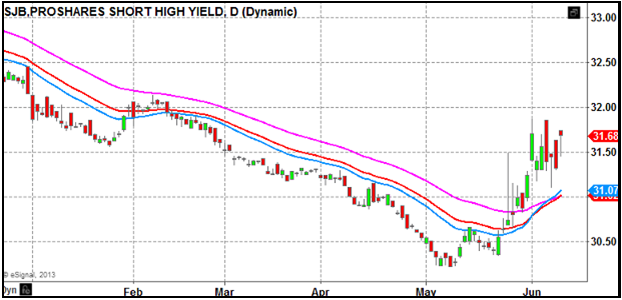Three Scenarios that Could Result in a Big Bond Rally
What Makes Me Wrong on Bonds?
It’s obvious to anyone reading this report over the past several weeks that I’m a big long-bond bear, that I think we’ve seen the “top” in Treasuries, and that a long decline in bond prices and a higher move in bond yields has begun.
I’m also aware that a “dovish” Bernanke this week could cause a short-term unwinding of the “higher-rates” trade and send TBF and TBT lower, while “yield-proxy” sectors like utilities and telecom and REITs rebound. But, I believe that any such trade would just provide an excellent entry point for the larger trend of higher rates.
But, like any good trader, I’m constantly thinking about what would happen that would make me wrong about the direction in bonds. Well, I thought about this over the weekend and there are three things that can happen that would make my opinion in bonds incorrect.
1. Scenario One: Japanese & Emerging-Market Debt Enter a Crisis Phase. The swings we’ve seen in emerging-market debt and the Japanese yen have, so far, been volatile but contained. But, if that volatility increases—and people begin to worry that emerging markets or Japan might lose the ability to sell debt and fund themselves—it would create a crisis. And in a crisis, money flows into U.S. Treasuries, as they remain the “safest” and most-liquid asset in the world. It would be the exact same thing that happened when Europe was in the depths of its crisis. European investors bought Treasuries for return “of” capital, not return “on” capital.
2. Scenario Two: Dis-Inflation Becomes “De-flation.” Fed President James Bullard has been one of the most-vocal of the Fed presidents voicing his concern for the low inflation readings globally. Low inflation, in an environment of massive liquidity, reflects a lack of demand for money and potential deflation. So, if the five-year inflation expectations on TIPS (one of the best measures of expected inflation), continue to decline—then the Fed will almost certainly abandon “tapering” and may even consider “more” QE.
3. Scenario Three: The Economy Sees A Summer Swoon—Again. I was speaking to a subscriber last week and he presented a counter argument from another analyst that basically said we’re in for years of 1%-2% GDP growth, low equity returns, and low bond returns. So, not quite the 20+ year deflation of Japan, but not that much better, either. In that scenario, there would be no Fed tapering and likely steady or more QE. Economic data will be the key to watch for this potential scenario.
I remain a bond bear and I believe I’m right on bonds, but I wanted these scenarios on paper so I can watch for them. Having too much confidence in this business is as dangerous as having too little.


